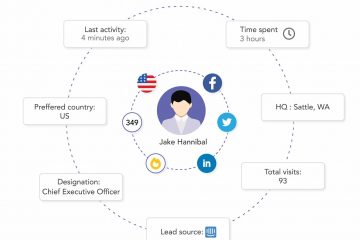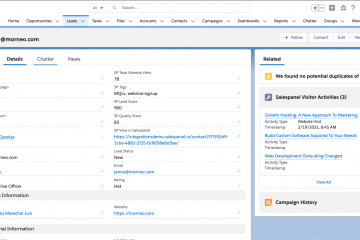Inbound Lead Generation Strategies for B2B Businesses
Broadly defined, getting to the point where you can start a conversation with your potential buyer is known as the lead generation process. Leads are mostly associated with sales but inbound lead generation is largely a part of marketing. Whether you are writing blogs to attract an audience or organizing events, there is a goal attached to your marketing activities, i.e., connecting with a prospect who may have an interest in your product or service. There is a list of activities that every B2B marketer creates to reach the goal, and the activities differ in respect of the nature of product/services, budget, and buyer personas. By the end of this post, you will know more about inbound and outbound lead generation and learn various inbound lead generation strategies.
Difference Between Inbound and Outbound
The core difference between inbound and outbound lead generation is that in the outbound marketing process, a marketer begins the conversation with someone to make them a lead. On the other hand, the inbound process lets a potential customer make the first move. You get to hear from them in various forms like forms, signups, direct messages, comments, etc. The other noticeable thing about inbound marketing is that it profusely depends on content marketing.
The lead generation process was not much organized traditionally. It’s only after the digital media took the front seat that we started seeing a new form of marketing that is more targeted, data-based, and result-oriented. We know it as the inbound lead generation process.
Outbound lead generation is still there and it still works with the use of cold emails, offline connections, referrals, and phone calls to connect with potential leads. This infographic by PureB2B cites clearly how Outbound VS Inbound Lead Generation are two different ways of attracting leads.

Inbound Marketing for B2B
Fundamentally, inbound marketing remains similar for all kinds of businesses- creating a bridge that connects the target audience with business. This bridge is a kind of walk-through that the audience chooses themselves (hence, all the noise about inbound marketing).
Just that creating leads for B2B differs immensely from B2C – majorly due to the target audience. One sells to businesses and the other to individuals. So there are various factors like goals, purpose, motivation, drivers that make inbound marketing for B2Bs a more challenging task.
1. The focus on ROI, efficiency, and expertise is higher in B2B marketing.
2. Purchase decisions are driven by logic and financial incentive.
3. Customers need to be educated first about the product/service/brand.
4. Salespeople have a pivotal role to play in the inbound lead generation process.
5. The sales cycles are longer – so are the customer-business relationships.
This latest guide by HubSpot on B2B Marketing says a lot about the trends and various approaches.
B2B Inbound Lead Generation Strategies
For an effective B2B lead generation plan, you must first dive deep into the studies that show the efficacy of various lead sources. SEO, social media, and email marketing are the top lead sources for B2B. They get 14% of the leads from SEO while investing 12% of the budget in it. A similar kind of survey shows email marketing is the most profitable lead source for B2B marketing and generates 62% of leads.
When we talk about inbound lead generation, our goal is not just to collect leads, it is about attracting the prospects that are most similar to our buyer personas. Knowing that 89% of B2B buyers research online, you can’t afford to miss the attention of the highest-level executives who are searching through the web for a similar product/service.
Targeting the right demographics through appropriate channels at various stages of sales funnel makes for the marketing qualified leads. These leads are further nurtured by the sales team to convert them into customers. So, the process of selling starts much earlier, i.e., right from the first eBook you publish or the product launch announcement made on social media.
In this article, we will take a deeper look at inbound lead generation strategies that are crucial going into 2021.
Identify Visitors
It is of utmost value to know who’s visiting your website and how they engage with it. This information helps in aligning marketing activities as constant tracking can tell if the visitors on your site match with the buyer personas or not, and reduce the wastage of budget.
Visitor analysis is the key to ensure that your content is reaching the right audience.
Even if you do everything right, over 80-90% of your website visitors will leave your website without converting into a lead. This essentially means that most of your traffic gets wasted. Salespanel helps you identify your website visitors and also analyze unidentified visitors and qualify them thereby increasing the overall opportunity available to you without increasing the number of visitors you send to your website or landing pages.
Lead Magnets
Over the years, the buying behavior has changed and the customers now look for a connection. Offering value at every stage of the marketing funnel is thus a must for inbound lead generation. A Lead magnet is a value that you can offer to an online user to become your subscriber. It could be whitepaper content, video, or a downloadable PDF- anything that is of value to the target visitor. They are not hesitant to share emails and a few details of what you offer in exchange is useful to them. This is actually a way to incentivize your visitors to become leads. For instance, you have a blog post on the basics of ‘sales funnel.’ At the end of your post, you can ask the readers to join your email list for similar updates or share their email to download a guide on effective pipeline management. Few examples of lead magnets are:
- Corporate Training Videos
- eBooks/Guides
- Case Studies
- Discount Codes
- Webinars
Search Engine Optimisation (SEO)
Getting traffic from search engines is every marketer’s dream. But, getting on the first pages of Google search results is highly competitive in 2021. That said, one thing that can still work in your favor is Backlinks.
Google algorithm still values high authority backlinks. So, create a lot of content that trusted domains would love to link to. Even high quality and relevant images and infographics can get you quality backlinks when other websites share it and give credit. From a prospects’ viewpoint, it builds trust in your brand and gives them a reason to check you out. Few steps you can take to have a great SEO strategy for B2B sales are:
1. Choose top-of-the-funnel keywords wisely. B2B buyers look for informative content and this is your moment to shine and educate them about your product/service. The top of the funnel keywords make way for the content which nurtures visitors to become leads.
2. Don’t forget to optimize your landing pages for searches- optimize relevant keywords and add long-form content.
3. Create a partner page to exchange links with your partners. Excessive direct exchanges are not advisable. Try to avoid this as much as possible.
4. Create a blog that’s insightful for your target customers. Write long-form content, with an intent to offer value to your readers. It will increase page stay as well as nurture your visitors’ interest.
5. Guest post on similar blogs with relevant content.
Advertising
Advertising is mostly considered more straight-forward for B2C players as their target audience is more active online and they research almost on every platform before buying.
B2B audiences, on the other hand, are more information focused, and the buying decision is typically not taken by one person- the strategy has to focus on different roles. Hence, advertising for B2B could be a little tricky.
That said, the number of marketers investing in social media ads is less, which makes it less competitive. According to 2020 CMI / Marketingprofs B2B Content Marketing Benchmarks report, 72% of surveyed marketers use social media for advertising and 61% do search engine marketing.
The one platform where you can reach out to C level executives and B2B professionals easily is LinkedIn. Reportedly, 80% of B2B leads come through LinkedIn. There are two ad options for B2B marketers: Sponsored Updates and Sponsored inMails. If you have to choose one among them, go with in-mails as that gives you a direct way to target certain roles.
PPC campaigns can prove themselves to be greatly profitable for the awareness stage as showing up on the first pages of search engines is highly competitive and time-consuming organically. So, for keywords that are highly competitive, you can invest in Google ads.
Among all other sources available for B2B advertising, YouTube, and Facebook Ads are great options for video ads and have a huge audience worldwide. You can advertise quick product videos, reviews, and promotions to get interested users to your website. The CPC for these ads remains relatively low and with retargeting options, you can reach out to visitors who haven’t converted yet. Such ads help build brand presence too if approached creatively. Even if targeting is hard for B2B on social media, your customers still spend time on Facebook and you can leverage this to show up in front of them.
Content Marketing
Content is the key to the success of any inbound lead generation campaign. Whether through search, social, or emails, it is content with which you can let your target audience discover you.
Typically, an inbound journey is divided into three phases: Attract, Consider, Convert. For B2B even if you show ads at the initial stages to attract new visitors, you have to be offering some information of their use. Similar to how you see dynamic ads from eCommerce sites. You can advertise relevant content to your target audience and get them to sign up for your newsletter. SEO also directly ties with content marketing. The more quality content you write, the more traffic you get. Content is king!
Now think of a B2B buyer in the same stage, will you get a click on a similar ad for a software subscription? An annual subscription differs in cost and applicability as compared to the other B2C product. One has to understand first how your software works, which unique problems you are going to solve for him/her, and then the value for money proposition. All of this and more can be communicated to the target visitors only through content marketing.
To begin the lead generation process, you must start with blogs, whitepapers, reports, infographics, and informative long-form or engaging content related to your niche. Share case studies, webinars, product demos with visitors who show interest in your first stage content.
B2B audiences want to be educated about a product/service before initiating a conversation with the sales team. Since they’re buying solutions for the long-term, they need to build trust in your brand first. Hearing from the industry leaders builds this confidence faster so investing a bit into thought leadership can work wonders for any B2B lead generation process.
There’s a lot that goes into capturing leads online. From blogs to SEO, PPC, and social platforms, your audience wants to feel connected, aware, educated, and valued. Content marketing is the most effective way to accomplish this. Your promotional choices have to be in line with your audience. So, the biggest responsibility for a B2B marketer is to define the promotion plan. Picking up the right platforms as per the marketing budget can be your main challenge in this regard.
Sell more, understand your customers’ journey for free!
Sales and Marketing teams spend millions of dollars to bring visitors to your website. But do you track your customer’s journey? Do you know who buys and why?
Around 8% of your website traffic will sign up on your lead forms. What happens to the other 92% of your traffic? Can you identify your visiting accounts? Can you engage and retarget your qualified visitors even if they are not identified?



